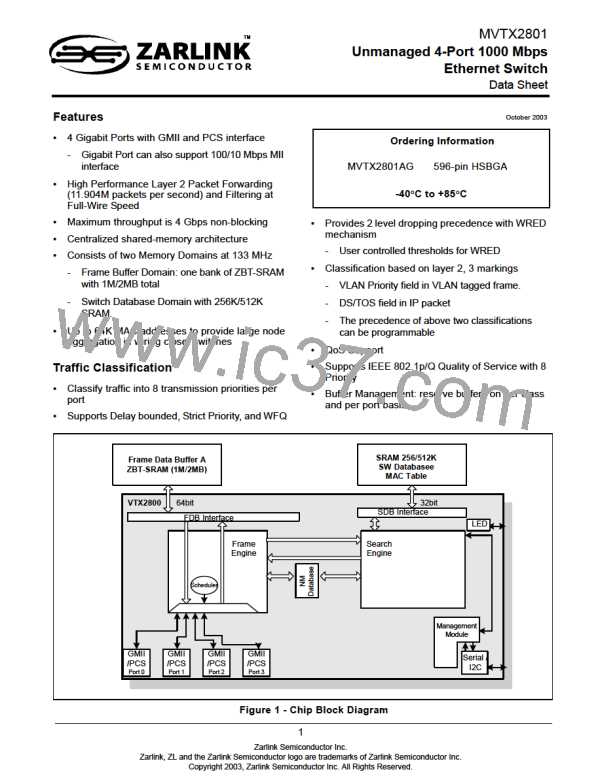MVTX2801
Data Sheet
classes to be used for non-essential traffic, because we provide no assurances about best effort performance.
However, in a typical network setting, much best effort traffic will indeed be transmitted, and with an adequate degree
of expediency.
Because we do not provide any delay assurances for best effort traffic, we do not enforce latency by dropping best
effort traffic. Furthermore, because we assume that strict priority traffic is carefully controlled before entering the
MVTX2801, we do not enforce a fair bandwidth partition by dropping strict priority traffic. To summarize, dropping to
enforce quality of service (i.e. bandwidth or delay) does not apply to strict priority or best effort queues. We only drop
frames from best effort and strict priority queues when global buffer resources become scarce.
7.5 Weighted Fair Queuing
In some environments - for example, in an environment in which delay assurances are not required, but precise
bandwidth partitioning on small time scales is essential (WFQ may be preferable to a delay-bounded scheduling
discipline). The MVTX2801 provides the user with a WFQ option with the understanding that delay assurances
cannot be provided if the incoming traffic pattern is uncontrolled. The user sets eight WFQ “weights” such that all
weights are whole numbers and sum to 64. This provides per-class bandwidth partitioning with error within 2%.
In WFQ mode, though we do not assure frame latency, the MVTX2801 still retains a set of dropping rules that helps
to prevent congestion and trigger higher level protocol end-to-end flow control.
As before, when strict priority is combined with WFQ, we do not have special dropping rules for the strict priority
queues, because the input traffic pattern is assumed to be carefully controlled at a prior stage. However, we do
indeed drop frames from SP queues for global buffer management purposes. In addition, queues P1 and P0 are
treated as best effort from a dropping perspective, though they still are assured a percentage of bandwidth from a
WFQ scheduling perspective. What this means is that these particular queues are only affected by dropping when
the global buffer count becomes low.
7.6 Shaper
Although traffic shaping is not a primary function of the MVTX2801, the chip does implement a shaper for expedited
forwarding (EF). Our goal in shaping is to control the peak and average rate of traffic exiting the MVTX2801. Shaping
is limited to class P6 (the second highest priority). This means that class P6 will be the class used for EF traffic. (By
contrast, we assume class P7 will be used for control packets only.) If shaping is enabled for P6, then P6 traffic must
be scheduled using strict priority. With reference to Table 2, only the middle two QoS configurations may be used.
Peak rate is set using a programmable whole number, no greater than 64 (register QOS-CREDIT_C6_Gn). For
example, if the setting is 32, then the peak rate for shaped traffic is 32/64 x 1000 Mbps = 500 Mbps. Average rate is
also a programmable whole number, no greater than 64, and no greater than the peak rate. For example, if the
setting is 16, then the average rate for shaped traffic is (16/64) x 1000 Mbps = 250 Mbps. As a consequence of the
above settings in our example, shaped traffic will exit the MVTX2801 at a rate always less than 500 Mbps, and
averaging no greater than 250 Mbps.
Also, when shaping is enabled, it is possible for a P6 queue to explode in length if fed by a greedy source. The reason
is that a shaper is by definition not work-conserving; that is, it may hold back from sending a packet even if the line
is idle. Though we do have global resource management, we do nothing to prevent this situation locally. We assume
SP traffic is policed at a prior stage to the MVTX2801.
7.7 WRED Drop Threshold Management Support
To avoid congestion, the Weighted Random Early Detection (WRED) logic drops packets according to specified
parameters. The following table summarizes the behavior of the WRED logic.
20
Zarlink Semiconductor Inc.

 ZARLINK [ ZARLINK SEMICONDUCTOR INC ]
ZARLINK [ ZARLINK SEMICONDUCTOR INC ]